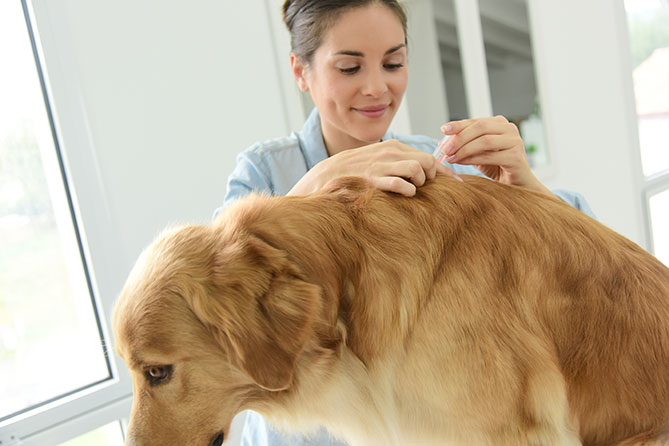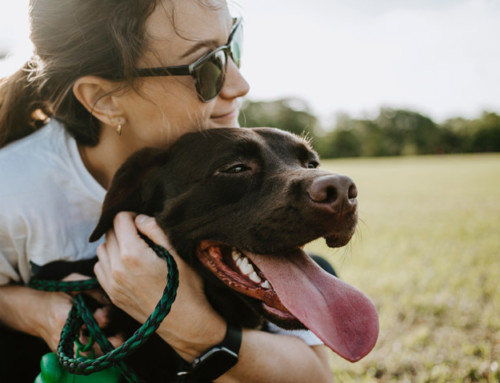There are many different species of fleas in Australia, and while they might not worry us too much, they can be irritating and dangerous for cats and dogs.
Cat fleas are around 3mm long and have long legs allowing them to jump. They have both genal and pronotal combs (ctenidia), differentiating them from most other fleas of domestic animals. A cat flea must pass through four stages: eggs, larvae, pupae and adult, and this cannot be completed when feeding on human blood alone. For this reason, most cat fleas will nest where their favoured host sleeps – the cat basket.
Dog fleas are a vector of the Dog Tapeworm, Dipylidium caninum, which can also affect humans. Brownish black in colour, they appear red following a meal and grow to around 4mm long. Again, these fleas have four stages to go through, but unlike cat fleas, they will happily jump from host to host.
Fleas are parasites that live exclusively by hematophagy, the consumption of blood from a host organism. Through evolution they have adapted to feeding on extremely specific variety of hosts, and fleas can today be pretty picky. Believe it or not there are some fleas that will only feed on a particular breed of cat or dog!
Fleas are an irritating fact of life for pet owners, and the lion’s share of the pet care industry is devoted to products aimed at combating fleas. Aside from just being irritating, fleas can cause flea bite dermatitis which leads to intense itching and scratching. This constant scratching allows the skin to break open and form scabs that get infected. Most frequently this is the back and base of the tail and if not treated it can lead to infection.
A second problem is that fleas can cause tapeworm. The tapeworm is initially inside the flea and then grows inside your pet. Again these can cause severe itching and can also cause sudden weight loss.
A third problem is flea bite anemia, common in puppies and kittens with a flea infestation. The fleas feed so much on these young animals that their red blood cell count decreases, causing them to become anemic. This will need medical attention, as left untreated it can be fatal.
In short – fleas should be prevented using the right products and prevention methods. You also want to protect your pets.
Preventing fleas
The adult fleas you see on your pet only make up 5% of the flea population. The other 95% are hiding in carpets, rugs, or cracks in floorboards in the form of eggs, larvae and pupae. Adult female fleas lay 50 eggs a day!
Fleas thrive in damp, shady areas in your garden and especially under the house. Their eggs can be passed from neighbourhood pets, rodents, and native wildlife. The spread of fleas is rapid, and just like most things, prevention is always better than cure.
Because fleas are such a big deal for pet owners, there are a plethora of flea products on the market. This can be confusing, and poor understanding of the flea population and how each product works can lead to failure, or ‘perception of failure’ of the product.
Whichever product you use you must always:
Read the instructions
This may sound obvious, but it really is important. The instructions will tell you the exact amount to use for your dog’s body weight, and will ensure you apply it in the right way. You could have the best product in the world, but if you don’t apply it correctly it can still fail. For example, some instructions will tell you not to bath your pet for 48 hours either side of treatment, while others require you to bath your pet right before applying.
Treat regularly
Many people only treat their pets during ‘flea season’ (the warmer months), but it’s important to treat pets all year round. Flea numbers do drop off in winter, but favourable conditions allow fleas to develop in the home all year round. If fertile eggs are laid in winter they can also lay dormant for up to six months, ready to strike once the summer rolls around.
Treat all pets
If you have two dogs but are only seeing fleas on one, don’t just treat the one with visible fleas. All animals in your household should be treated, even if they don’t go outside. Otherwise fleas can easily survive on untreated pets and you’ll soon find a re-infestation.
Treat the environment
If your pet has a large infestation it could be worthwhile treating your entire home rather than just your pet. Flea bombs or fumigation can cease a large outbreak, and when kept up regularly can prevent infestations from forming. Your pet will need to be out of the house for the day when the extermination/bombing is occurring.
Speak to your vet or pet shop provider
Finding the best treatment for your pet will depend on varying factors. A qualified professional can help you with this. When buying products, avoid generic products sold in supermarkets, as many of these won’t do the job you want them to do. Instead, look to purchase topicals and sprays such as Advantix and Frontline Plus for dogs which will kill adult fleas for one month once applied and help protect against ticks. For cats try products like Revolution or Advocate, which will also kill roundworms, heartworm and some mites.
If you prefer the idea of tablets you might like Capstar or Comfortis, licensed in dogs only. Just bear in mind that these do not offer tick protection.
Consult with your veterinarian if you’re concerned about any products you are thinking of using, and if your pet has a reaction to a treatment ensure you take them to the vet as quickly as possible.
Live cleanly
To help minimise flea numbers in between treatments, vacuum your home regularly (vacuum, not sweep), wash bedding in hot temperatures (including pet bedding), use crawling insect sprays under shelves, and keep lawns short. If fleas keep recurring, it could be a sign that you have an unearthed damp area in your home, so check for this and eliminate the problem as soon as possible.
Consider a combination
If you have noticed a large number of adult fleas and nothing seems to be working, try using a combination of products. Combining Comfortis with Sentinel for example is a combination heavily recommended by Australian vets and is often referred to as the ‘gold standard’ of flea treatments.
Keeping your pets flea-free
As a responsible pet owner, it’s not enough to simply know that fleas are a problem in Australia. You must take action against them from the moment you bring your pet home, and by doing so you can rest easy knowing your pet and home are safe from fleas.







Leave A Comment